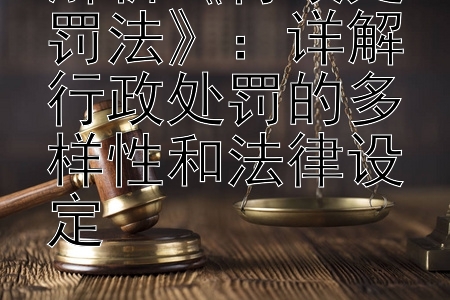《中华人民共和国行政处罚法》(以下简称《行政处罚法》)是规范行政机关正确行使行政权力、依法实施行政处罚的重要法律依据。该法对行政处罚的种类和幅度进行了明确规定,这些规定直接影响了行政机关在执法实践中的行为方式和对违法行为的处理结果。本文将探讨《行政处罚法》如何通过设定行政处罚的种类和幅度,来实现公正、合理的行政执法目的。
一、行政处罚的种类与含义 根据《行政处罚法》的规定,行政处罚是指行政机关依法对违反行政管理秩序的公民、法人或者其他组织,以减损权益或者增加义务的方式予以惩戒的行为。具体包括以下几种类型: 1. 警告; 2. 罚款; 3. 没收违法所得、没收非法财物; 4. 责令停产停业; 5. 暂扣或者吊销许可证、执照; 6. 行政拘留; 7. 法律法规规定的其他行政处罚。
二、行政处罚的幅度限制 为了确保处罚既能起到教育作用,又能产生威慑效果,同时避免过度惩罚或滥用职权,《行政处罚法》对每一种类行政处罚的幅度都做了相应的限制。例如: - 对警告这种较轻的行政处罚,法律并未对其金额作出限制。 - 而对于罚款这一较为常见的行政处罚形式,法律规定了不同的罚款额度,如“一定数额以上”、“不超过某一特定金额”等,以便行政机关可以根据违法行为的情节轻重合理确定罚款数额。 - 在涉及人身自由的行政拘留方面,则严格控制适用条件和期限,防止不当使用此种严厉手段。
三、 The Article Title: "Investigating the Impact of the Administrative Penalty Law on the Types and Magnitudes of Administrative Penalties"
Introduction: The Administrative Penalty Law is a crucial legal document that regulates administrative organs' correct exercise of administrative power, as well as their implementation of administrative penalties in accordance with the law. This article will explore how the Administrative Penalty Law affects the types and magnitudes of administrative penalties through its stipulations.
I. Types of Administrative Penalties According to the Administrative Penalty Law, administrative penalties refer to actions taken by administrative organs against citizens, legal persons or other organizations who violate administrative management order, which reduce rights or impose obligations as a form of disciplinary action. These include but are not limited to:
- Warning;
- Fine;
- Confiscation of illegal gains and illicit goods;
- Ordering business suspension or closure;
- Suspension or revocation of permits or licenses;
- Administrative detention;
- Other administrative penalties specified by laws and regulations.
II. Limitations on the Magnitude of Administrative Penalties To ensure that punishments serve both an educational purpose and act as deterrents, while avoiding excessive punishment or abuse of authority, the Administrative Penalty Law places limitations on the magnitude of each type of penalty. For example:
- Warnings, being relatively mild penalties, do not have specific monetary limits set.
- Fines, on the other hand, are subject to various restrictions regarding amounts, such as "a certain amount upwards" or "not exceeding a particular sum", allowing for discretionary determination based on the severity of the violation.
- In cases involving deprivation of personal freedom via administrative detention, strict control over application criteria and duration is maintained to prevent inappropriate use of this severe measure.
III. Case Studies To illustrate the practical implications of these provisions, consider the following case studies:
Case Study 1: A local restaurant was found to be using expired ingredients in its dishes. As a result, it faced a series of penalties including being ordered to suspend operations until it rectified the issue, being fined several times its daily revenue, and having its food service permit suspended pending further investigation. These penalties were determined within the scope allowed by the Administrative Penalty Law and aimed at correcting the behavior while maintaining public health standards.
Case Study 2: An individual illegally sold counterfeit products online. They faced fines totaling tens of thousands of yuan, as well as having their e-commerce platform account frozen and being prohibited from engaging in similar activities for a period of time. This case demonstrates how the Administrative Penalty Law provides flexibility in determining penalties while ensuring they are proportional to the offense committed.
Conclusion: The Administrative Penalty Law plays a pivotal role in guiding administrative bodies to implement fair and reasonable penalties. By setting out clear parameters for types and magnitudes of sanctions, it helps create a predictable environment where individuals and businesses can adjust their conduct accordingly, fostering compliance with regulatory requirements across society.
